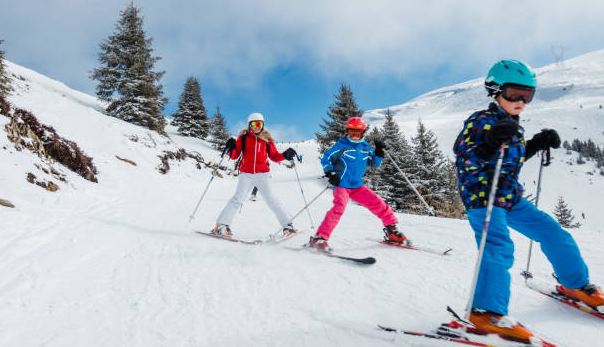Novice skiers are sometimes bewildered by snow conditions that can vary from day to day. Just when you think you have mastered one type of snow, you are suddenly faced with icy patches or crud.
These different skiing conditions are a big part of what makes this sport so fun and exciting. Relax! With a little time and practice, you will be able to perform like a seasoned pro on any surface.
Snow texture on ski trails is impacted by both weather conditions and the amount of people who are using the trail.
Snow can vary in moisture content and density. Commonly, the colder the weather, the drier the snow.
The longer that snow remains on the ground, the denser and heavier it gets. When a lot of skiers are using a trail of older snow, icy patches usually develop because the action of the skis over the snow causes it to melt and then freeze again.
Here are some examples of snow conditions that you are likely to come across as the season progresses:
Powder
Skiers love powder! This is newly fallen, soft, fluffy snow that’s untouched by other skiers. The vast majority of enthusiasts regard skiing on fresh powder as the ultimate skiing experience.
Some will travel obscene distances to get to powder. Powder demands a unique skiing technique, though, and the beginner may fall a lot.
At least the snow is soft and dry enough to even make falling a delight! The greatest challenge when skiing powder is to keep your weight distributed over the skis evenly.
Since the snow is so delicate, excess pressure on one ski will cause it to sink. It is also necessary to shift your weight more to the rear than on more stable snow surfaces.
Crud
Crud is powder that has been skied on. As more skiers use the slope the trail turns into a patchwork of virgin and packed snow.
This presents the challenge of perpetually changing surfaces as you work your way down the slope.
Skiing on crud can be fun but calls for a more aggressive technique than skiing on powder. Your knees should be kept bent to absorb the impact of the deeper sections of snow, and you will have to be constantly alert to what is approaching.
Crust
Crusty snow has a hard surface on top of softer powder. Crust is formed when the sun melts the top layer of snow and it then refreezes.
Crusts can be either hard or soft. Hard crusts ordinarily do not pose a problem since the skier will stay on top, but softer crusts will break.
Skiing through soft crust can be a true challenge because your sideways movements will be somewhat restricted.
The most intriguing altogether is an intermixture of hard and soft crusts. Hitting a section of the hard crust while skiing through a soft crust can cause a nasty crash.
Ice
Ice is the most challenging and the least amusing. If your skis are angled as they cross ice they will slip out from underneath you causing you to wipe out.
Ordinarily, only parts of the slope will have ice patches and they can be spotted by their coloration. The key to skiing icy slopes is to keep alert and flatten your skis whenever crossing an ice patch.
Slush
Slush is very soft, wet snow. It’s created by warming temperatures that cause the snow to melt. Because the snow is dense, it requires a fair amount of effort to turn.
Gentle, gradual turns are more successful than quick maneuvers, which likely will cause your skis to get caught in the snow and make you wreck.
Falling in slush is definitely not fun! If you are a skilled hard-core skier desiring to squeeze the last few days out of the season, possibly you can tolerate slush. All but these few diehards are better off avoiding it.
Whatever snow conditions you encounter – have fun!

